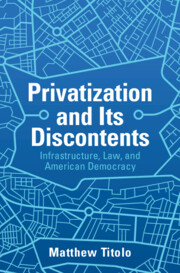Book contents
- Privatization and Its Discontents
- Privatization and Its Discontents
- Copyright page
- Dedication
- Contents
- Acknowledgments
- Introduction
- 1 Early Liberalism, Adam Smith, and the Seeds of the Infrastructural State
- 2 Forging the Infrastructural State
- 3 “A Wilderness of Turnpike Gates”
- 4 The Panic of 1837 and the Infrastructure Crash
- 5 “The Ground under Our Feet”
- 6 The Death of Laissez-Faire and the Rise of Infrastructure in the Cold War
- Conclusion
- Index
5 - “The Ground under Our Feet”
The Birth of Public Utilities
Published online by Cambridge University Press: 08 June 2023
- Privatization and Its Discontents
- Privatization and Its Discontents
- Copyright page
- Dedication
- Contents
- Acknowledgments
- Introduction
- 1 Early Liberalism, Adam Smith, and the Seeds of the Infrastructural State
- 2 Forging the Infrastructural State
- 3 “A Wilderness of Turnpike Gates”
- 4 The Panic of 1837 and the Infrastructure Crash
- 5 “The Ground under Our Feet”
- 6 The Death of Laissez-Faire and the Rise of Infrastructure in the Cold War
- Conclusion
- Index
Summary
As state and local governments moved into the infrastructure field, they also revolutionized public finance and set the stage for infrastructure politics in the twentieth century. Governments at every level broadened their fiscal footprints to accommodate new infrastructure development after the Civil War. Governments were not supposed to direct public money into private hands, but this legal principle was in inevitable conflict with the public–private model of infrastructure development. In any event, state governments created numerous workarounds, most notably by allowing cities to tax and spend instead of states doing it themselves. Finally, the Civil War fundamentally changed the balance of power between federal and state governments. The 14th Amendment seemed to promise a new era of expanded rights for black Americans and other groups against discriminatory state power. As public power spread like a web over economic life, conservative jurists such as Ernst Freund, Christopher Tiedemann, Thomas Cooley, and others asked whether there were any limits at all on government power to advance what legislatures called “the public good.” Their views would inform laissez-faire legalism from its rise after the Civil War until its demise in the 1930s.
Keywords
- Type
- Chapter
- Information
- Privatization and Its DiscontentsInfrastructure, Law, and American Democracy, pp. 134 - 168Publisher: Cambridge University PressPrint publication year: 2023

